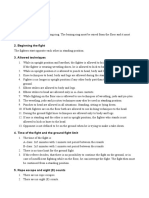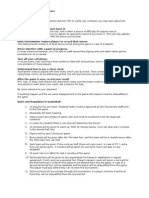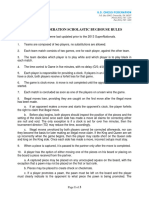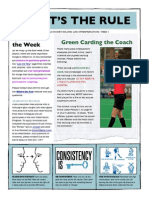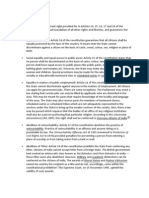Rules Summary F2009 CSimonian
Rules Summary F2009 CSimonian
Uploaded by
scameron1023Copyright:
Available Formats
Rules Summary F2009 CSimonian
Rules Summary F2009 CSimonian
Uploaded by
scameron1023Original Description:
Original Title
Copyright
Available Formats
Share this document
Did you find this document useful?
Is this content inappropriate?
Copyright:
Available Formats
Rules Summary F2009 CSimonian
Rules Summary F2009 CSimonian
Uploaded by
scameron1023Copyright:
Available Formats
1 Valid Target Area
Fencing Rules Summary
(Simonian)
In foil fencing, the torso is the valid target. In front, the target extends from the top of the collar down to the creases formed between the thigh and the lower abdomen. In back, the target extends from the top of the collar down to a line connecting the tops of the hip bones. The electric foil vest is cut to exactly cover the torso. The U.S.F.A. Rules Rook contains not only the rules for the foil, epee, and sabre, but also describes and gives specification for fencers' equipment, weapons, and clothing and provides considerable information on meet organization. Following are some of the more important rules of concern to the beginner. 1. An attack is correctly executed when the swordarm is being straightened and the point is continuously threatening the opponents target as the lunge, advance lunge, or fleche begins. 2. The compound attack (e.g., 1-2. double) is correctly executed when the swordarm is being straightened with the first feint, the point threatening the opponent's target. The arm must not bend between successive actions and the initiation of the lunge. 3. In the advance lunge, the arm must be straightened by the end of the advance prior to the lunge. 4. If a defender is "in line" (i.e.. arm straight, point threatening), the attacker must first deflect the defender's blade to obtain the priority. 5. A successful parry gives the right to riposte but the riposte must be made immediately. 6. During a compound attack, the attacker must avoid the opponent's attempts to parry. The opponent may riposte if the blade is met during the feints. 7. If there are simultaneous touches and both fencers had attacked correctly, no touch is scored even if one hit off-target. 8. If there are simultaneous touches and one fencer attacked correctly while the other did not, there is a "double hit" and only the correct attacker gets the point. 9. A remise or redoublement may count if it hits during a delay in the riposte or if the riposte fails to hit. 10. An off-target hit requires that the action be halted, and touches made after the off-target touch cannot be counted. 11. The referee must observe that fencers stay on the strip. If a fencer leaves the strip side with one foot, the bout is halted and the fencer is replaced on the strip without penalty. 12. If a fencer goes off the side of the strip with both feet, the bout is halted and the fencer's opponent moves forward one meter and the offending fencer moves back the same distance. 13. When a retreating fencer crosses the end line with both feet. the opponent is given a point. 14. If a fencer is disarmed, the bout is immediately halted. However, if a defender is disarmed during a single, continuous action (e.g.. beat lunge) which arrived on the defender's valid target. the attacker's touch will count. 15. Infighting, that is fencing at close quarters without body contact, is permitted for only so long as the referee can follow the action and both fencers can freely use their foils. There is no priority and the first to score will get the point. 16. A bout is won when a fencer has scored the requisite number of touches or when time has run out with one fencer leading. If the score is tied with time expired, the referee tosses a coin and declares one fencer to have the advantage. During an additional minute of fencing, the first to touch will win the bout, but if the score remains tied, the one with the advantage is the winner.
Summary of Penalties Types of Penalties The referee can impose any of the three types of penalty on a fencer who has violated one of the rules of the sport. Certain offenses can result in the annulment of a touch scored by the fencer at fault. The penalties are said to be cumulative and valid only for the bout being fought and do not carry over to other bouts in the pool. Note, how-ever, that if a Black Card is given the fencer is excluded from the competition. The penalties as listed in the U.S.F.A. rules book are as follows: ! a warning, indicated by a Yellow Card with which the Referee identifies the fencer at fault. The fencer then knows that any further offence on his part will result in a penalty touch. ! a penalty touch. demonstrated by a Red Card with which the Referee identifies the fencer at fault. A touch is added to the score of the opponent and may, if the last touch is at stake, leadto the loss of the bout. Furthermore, a Red Card can only be followed by another Red Card or by a Black Card depending on the nature of the second offence. !exclusion, from the competition or the whole tournament as applicable (for a fencer), or expulsion from the competition venue (any person disturbing the order of the competition), demonstrated by a Black Card by which the Referee identifies the fencer or person at fault. The rules book describes four groups of offenses, but most of the penalties ordinarily imposed fall into the first group and result in Yellow Cards being given followed by Red Cards for any further violations in the same bout 1. Offenses in the first group The first occurrence is penalized by a Yellow Card. If the fencer commits another offense in this group during the same bout, he will receive a Red Card each time. In the typical tournament, the referee does not actually show a card but merely announces which warning or penalty is being given. Following are a few examples of yellow card penalties from the first group of offenses: a) Placing the unarmed hand in front of valid target b) Using the unarmed hand to defend. c) Turning the back to the opponent during a phrase. d) Deliberately leaving the side of the strip to avoid being touched. e) Falling down, even though accidentally. A hand touching the floor is not a violation. f) Jostling the opponent during a phrase. g) Reversal of the shoulders. The rear shoulder may not be advanced ahead of the lead shoulder. h) In electric foil, reporting to the strip with defective equipment such as a foil which does not support the test weight. See the U.S.F.A. Rules Book for a complete list of violations and penalties. 2. Offenses in the second group Each offense is penalized by a Red Card (penalty touch) from the first occurrence. These offenses do not get any prior warnings. In this group the penalty is imposed for: Interruption of bout for claimed injury not confirmed by a doctor. Absence of weapon inspection marks. Dangerous, violent or vindictive action, blow with guard or pommel. 3. Offenses in the third group The first infringement is penalized by a Red Card (penalty touch). If the fencer commits, during the same bout, another offense in this group, he will receive a Black Card (expulsion from the meet). Offenses in this group include disturbing order on the strip, dishonest fencing, and refusal to salute. 4. Offenses in the fourth group The first infringement in this group is penalized by a Black Card (exclusion from the competition). These are the most serious violations and include doping, cheating with the equipment, offense against sportsmanship, and deliberate brutality.
You might also like
- Letter To Board of New Starship Foundation - Revised v3Document3 pagesLetter To Board of New Starship Foundation - Revised v3Ars TechnicaNo ratings yet
- Vale Tudo RulesDocument5 pagesVale Tudo RulesjamesfletcherNo ratings yet
- Introduction To FencingDocument5 pagesIntroduction To FencingNur FarishaNo ratings yet
- WEKAF Tournament RulesDocument13 pagesWEKAF Tournament RulesKick KidzNo ratings yet
- StandUpFightLight RulesDocument10 pagesStandUpFightLight Rulesrene david villacis orqueraNo ratings yet
- Single VolleyDocument2 pagesSingle VolleyJulianne MarieNo ratings yet
- Low-Kick RulesDocument9 pagesLow-Kick RulesdaveNo ratings yet
- Rules and Regulation On Chess Volleyball Basketball and BadmintonDocument5 pagesRules and Regulation On Chess Volleyball Basketball and BadmintonZerlin Duran0% (1)
- Badminton IrrDocument3 pagesBadminton Irrkencalvelo698No ratings yet
- Wrestling Rules and ScoringDocument8 pagesWrestling Rules and Scoringzainshabbirs39No ratings yet
- OSMAT Continuous RulebookDocument16 pagesOSMAT Continuous RulebookKayne M. DewhurstNo ratings yet
- Indoor Volleyball Rules: Playing AreaDocument10 pagesIndoor Volleyball Rules: Playing AreaRashdan MamatNo ratings yet
- FootballDocument50 pagesFootballMajid HabibNo ratings yet
- Module 8Document19 pagesModule 8MARK URIEL SAGANANo ratings yet
- 2.ultimate FrisbeeDocument59 pages2.ultimate FrisbeeCharles Immanuel TolosaNo ratings yet
- The Rules of A Football GameDocument6 pagesThe Rules of A Football Gameducanhpham12c7.03No ratings yet
- The 17 Laws of Soccer ExplainedDocument4 pagesThe 17 Laws of Soccer ExplainedJennette BelliotNo ratings yet
- 2017-Beach-Vball-rulesDocument3 pages2017-Beach-Vball-rulesfab.m.amoNo ratings yet
- Rules and RegulationsDocument3 pagesRules and RegulationsLary Lou VenturaNo ratings yet
- Guide To Volleyball Basics 2006Document5 pagesGuide To Volleyball Basics 2006api-443435287No ratings yet
- 3 Fouls and Violations in BasketballDocument4 pages3 Fouls and Violations in Basketballmarvinfajardo026No ratings yet
- Rules and Regulation1Document2 pagesRules and Regulation1Delwar HossainNo ratings yet
- Ultimate in 10 Simple RulesDocument1 pageUltimate in 10 Simple RulesLednelg YosoresNo ratings yet
- TASK SHEET No. 1.3 PE 4Document7 pagesTASK SHEET No. 1.3 PE 4Chrischia Yvonne GualbertoNo ratings yet
- Module 104 SportsDocument11 pagesModule 104 SportsLeonso Visto JrNo ratings yet
- Piat Academy: Official Volleyball Hand SignalsDocument6 pagesPiat Academy: Official Volleyball Hand SignalsHannaNo ratings yet
- WEKAF Rules Full ContactDocument16 pagesWEKAF Rules Full ContactSunny NguyễnNo ratings yet
- Rules and Regulations in BadmintonDocument9 pagesRules and Regulations in BadmintonJan MakilingNo ratings yet
- Amateur Kabaddi Federation of IndiaDocument7 pagesAmateur Kabaddi Federation of IndiaKumar ShivamNo ratings yet
- 5 On 5 Flag Football Rules and RegulationsDocument6 pages5 On 5 Flag Football Rules and RegulationsOnhis BerthosNo ratings yet
- G7 Flag Football RulesDocument12 pagesG7 Flag Football RulesDoug WashingtonNo ratings yet
- Screenshot 2024-04-21 at 2.59.07 PMDocument16 pagesScreenshot 2024-04-21 at 2.59.07 PMYash GuptaNo ratings yet
- 13 Game CrudDocument5 pages13 Game CrudKerry WeiNo ratings yet
- Badminton RulesDocument3 pagesBadminton Rulescristineangeljasmin04No ratings yet
- PathFit-3BadmintonDocument14 pagesPathFit-3Badmintonelvielagare30No ratings yet
- EuroTouch Rules 2015Document6 pagesEuroTouch Rules 2015Jorge Luis Martinez PelaezNo ratings yet
- BughouserulesDocument3 pagesBughouserulesJohn Doe 32-8No ratings yet
- WAKO Point Fighting RulesDocument10 pagesWAKO Point Fighting RulesLauren Jade WeisnerNo ratings yet
- Badminton AssignmentDocument6 pagesBadminton Assignmentadejessica226No ratings yet
- Saint Ferdinand College: College of Teacher EducationDocument6 pagesSaint Ferdinand College: College of Teacher EducationMhadellaine JunatasNo ratings yet
- Tennis RulesDocument7 pagesTennis Rulesjaintarun40No ratings yet
- Rules of Beach KabaddiDocument10 pagesRules of Beach KabaddiAnonymous MQjBLReGmXNo ratings yet
- 2008 Netball RulesDocument7 pages2008 Netball RulescikganshuNo ratings yet
- 4 On 4 RulesDocument2 pages4 On 4 Rulesapi-25498632No ratings yet
- 2020 Caraa New Guidelines GroundrulesDocument9 pages2020 Caraa New Guidelines GroundrulesJennyhyn cruzNo ratings yet
- Rules For Laban ArnisDocument1 pageRules For Laban Arniskarenjoy palomaresNo ratings yet
- Palarong Pambansa: (Billiard Sports)Document10 pagesPalarong Pambansa: (Billiard Sports)Dustin Andrew Bana ApiagNo ratings yet
- Jjif Ne Waza Rules 2010Document14 pagesJjif Ne Waza Rules 2010Debreczi SzilamerNo ratings yet
- Rli Euro Tag RulesDocument5 pagesRli Euro Tag RulesJorge Luis Martinez PelaezNo ratings yet
- MODULE-4Document9 pagesMODULE-4jen335971No ratings yet
- Badminton HistoryDocument35 pagesBadminton HistoryAdm Art CraftsNo ratings yet
- Yoon's Hap Ki Do Tournament Rules and ConductDocument5 pagesYoon's Hap Ki Do Tournament Rules and ConductCatalin ChiriacNo ratings yet
- Badminton and Table TennisDocument17 pagesBadminton and Table TennisKen SugiyamaNo ratings yet
- Rules of The GameDocument5 pagesRules of The GameAvox EverdeenNo ratings yet
- Accounting Physical EducationDocument4 pagesAccounting Physical EducationwerrNo ratings yet
- Badminton RulesDocument2 pagesBadminton RulesJaytantra KumarNo ratings yet
- IMMAF Rules Document As of Oct 2022Document13 pagesIMMAF Rules Document As of Oct 2022obec.faleconoscoNo ratings yet
- Understanding Chess Tournament RulesDocument2 pagesUnderstanding Chess Tournament Rulessmarthood2000No ratings yet
- CIAC FIeld Hockey: Interpretations From Week 1Document4 pagesCIAC FIeld Hockey: Interpretations From Week 1FHRules101No ratings yet
- The Rules of Rugby Football as Framed by The International Rugby Football BoardFrom EverandThe Rules of Rugby Football as Framed by The International Rugby Football BoardNo ratings yet
- M5 My Crime Report FinalDocument1 pageM5 My Crime Report FinalThomas Celio Boynton CombaNo ratings yet
- Lacson vs. Executive SecretaryDocument3 pagesLacson vs. Executive SecretarycriselkateNo ratings yet
- Law Relating To Protection of Women Against Offence of Rape in India: A Critical Analysis With Respect To Role of Judiciary'Document37 pagesLaw Relating To Protection of Women Against Offence of Rape in India: A Critical Analysis With Respect To Role of Judiciary'IshwarNo ratings yet
- Name: Grade: Initial Test 1. Read The Text Below and Complete The Summary Below With Information From The Text: (15 Points)Document2 pagesName: Grade: Initial Test 1. Read The Text Below and Complete The Summary Below With Information From The Text: (15 Points)Carmen Liliana SamoilaNo ratings yet
- Howell Donaldson MotionDocument8 pagesHowell Donaldson MotionABC Action NewsNo ratings yet
- Fundamental RightsDocument7 pagesFundamental RightsDipunjay GogoiNo ratings yet
- Alejandro V PepitoDocument3 pagesAlejandro V PepitotrishortizNo ratings yet
- Letter of Permission To Undergo OjtDocument15 pagesLetter of Permission To Undergo Ojtandaliol706No ratings yet
- Tcs Employment Application FormDocument5 pagesTcs Employment Application FormNehaNo ratings yet
- Forensic Nursing Science: Global Strategies in Health and JusticeDocument8 pagesForensic Nursing Science: Global Strategies in Health and JusticeFebri ArifNo ratings yet
- Euthyphro (Excerpt) : 4.2. Historical SettingDocument5 pagesEuthyphro (Excerpt) : 4.2. Historical SettingAnaa LegaspiNo ratings yet
- Personal Identification PPT MODULE 1 2Document26 pagesPersonal Identification PPT MODULE 1 2Ira Sales100% (1)
- Oblicon 1-13Document28 pagesOblicon 1-13BGodNo ratings yet
- ShortStory - "Unsung Hero - Tatang"Document2 pagesShortStory - "Unsung Hero - Tatang"s2020106372No ratings yet
- Crime Practice ExercisesDocument6 pagesCrime Practice ExercisesLeticia CorralNo ratings yet
- 86826-2014-Implementing Rules and Regulations ofDocument9 pages86826-2014-Implementing Rules and Regulations ofMD GarciaNo ratings yet
- Beverly Evadne Bent, A017 521 783 (BIA April 21, 2017)Document7 pagesBeverly Evadne Bent, A017 521 783 (BIA April 21, 2017)Immigrant & Refugee Appellate Center, LLCNo ratings yet
- Test Bank For Introduction To Criminal Justice Practice and Process 4th Edition Kenneth J Peak Tamara D Madensen HeroldDocument39 pagesTest Bank For Introduction To Criminal Justice Practice and Process 4th Edition Kenneth J Peak Tamara D Madensen HeroldDanielRogerscdsq100% (38)
- VisaApplicationForm ExampleDocument2 pagesVisaApplicationForm ExampleWisheth RandikaNo ratings yet
- Personnel Action Form: More Than 30 Days Requires SVP ApprovalDocument2 pagesPersonnel Action Form: More Than 30 Days Requires SVP ApprovalLegend AnbuNo ratings yet
- Laws Releated To Honour KillingDocument2 pagesLaws Releated To Honour KillingMukul Singh RathoreNo ratings yet
- Defamation in Cyber SpaceDocument12 pagesDefamation in Cyber SpaceamanNo ratings yet
- Ideas To Add Into MusicalsDocument1 pageIdeas To Add Into Musicalssimu.upadhyayaNo ratings yet
- HB 1477Document2 pagesHB 1477WSETNo ratings yet
- 4 Steps To Flip Money On PayPal and Get Away With ItDocument5 pages4 Steps To Flip Money On PayPal and Get Away With Italihussle3200blxkNo ratings yet
- 130812-COMPLAINT Ref Brendan Facey Director IM&ES - Sheriff) OBL 1106575301Document11 pages130812-COMPLAINT Ref Brendan Facey Director IM&ES - Sheriff) OBL 1106575301Gerrit Hendrik Schorel-HlavkaNo ratings yet
- Module 5 Cyber CrimesDocument23 pagesModule 5 Cyber CrimesHridya sNo ratings yet
- Ophelia Hernan v. SandiganbayanDocument9 pagesOphelia Hernan v. SandiganbayannazhNo ratings yet
- Supportive Residents & Carers Action Group IncDocument5 pagesSupportive Residents & Carers Action Group IncMaverick MinitriesNo ratings yet

